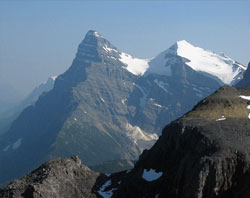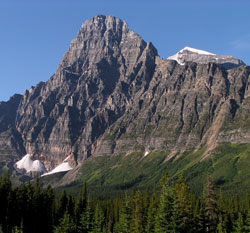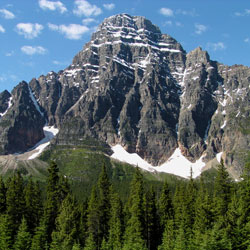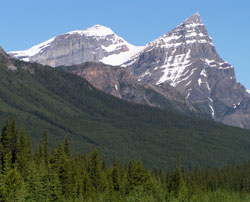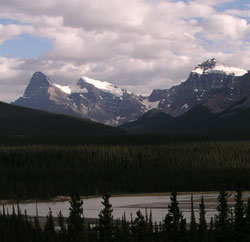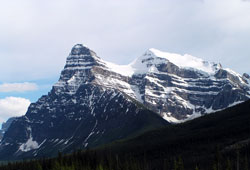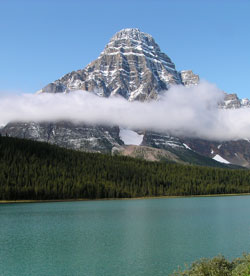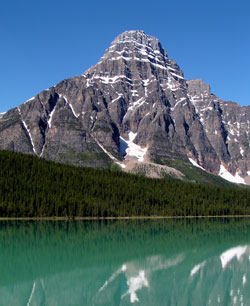
Photo: Looking west across Lower Waterfowl Lake to Mount Chephren from the Icefields Parkway
Mount Chephren
- 3266 m (10,716ft)
- First Ascent
- Naming History
Located in the Mistaya River Valley 4 km west of Waterfowl Lakes
Province: Alberta
Park: Banff
Headwater: Saskatchewan
Major Valley: Mistaya
Visible from Highway: 93N
Ascent Party: J.W.A. Hickson.
Ascent Guide: Edward Feuz jr.
Named by: J. Monroe Thorington
Named for: Chephren, or Khafre, was the fourth pharaoh of the Fourth Dynasty of Egypt and built the second of the three Great Pyramids.
Towering over the Lower Waterfowl Lake, the steep, cliffs of Mount Chephren are most impressive as they rise 1600 metres above the valley floor. The lower part of the mountain is made of reddish and pinkish quartzites of Lower Cambrian age. The higher levels are made of younger, grey limestones. Mount Chephren is a landmark in the Mistaya Valley, not only because of its height and distinctive shape but also because it is positioned somewhat to the northeast of the other peaks that form the southwest side of the valley. This enables it to be seen for a considerable distance from both the upper and lower Mistaya Valley. Mount Chephren was named Pyramid Mountain by J. Norman Collie in 1897. At the same time he named its neighbour, which was covered in snow, White Pyramid. Pyramid Mountain, in contrast, had very little snow. The peak was a favourite of Mabel Williams who, in 1948, wrote a wonderful guidebook for what was then called, "The Banff-Jasper Highway." Of Mount Chephren she wrote, "Even in this region of magnificent peaks, Mount Chephren stands out with a supreme majesty and beauty all its own. Anong all mountain lovers it will always hold high place. Its dark frontal tower of purplish rock rounded to a beehive, its immense, deeply carved buttresses, the symmetrical bands of darker rock and dazzling snow which crown its summit give it an individuality which stamps itself at once on the memory. A luxurient forest throws its cloak of living green about its feet, but, above, the great walls rise in naked precipices for nearly a mile. Lying upon the main mass of the mountain is an immensely thick ice cap which sweeps down around the great tower in a pure white snow saddle like a white scarf flung over its shoulders." In 1918 the Interprovincial Boundary Commission decided that Pyramid Mountain's name must be changed in order to avoid confusion with the Pyramid Mountain near Jasper. J. M. Thorington, a prominent mountaineer and author of the era, liked the association of the peak with the pyramids of Egypt and recommended the name Chephren. Chephren, or Khafre, was the fourth pharaoh of the Fourth Dynasty of Egypt and built the second of the three Great Pyramids. His reign began in 2565 BC and it is his likeness which is thought to have been the model for the Sphinx. White Pyramid's name was thought to be different enough from the Pyramid Mountain near Jasper and that name was retained. THE PYRAMIDS OF THE CANADIAN ROCKIES There are at least seven mountains in the Canadian Rockies that have been known as "Pyramid." Only two officially carry the name, a third having had the name removed in order to avoid confusion with the other "Pyramids.” Peter Fidler was the first European to enter the Canadian Rockies and the first to name a peak. He noted in his journal on December 7, 1792 that he saw a, “remarkable high cliff…very much resembling a pyramid –from which very near resemblance I shall call it by that name.” He measured bearings to the feature and used it to calculate his position. It is likely that he was referring to what we now know as Mount Glasgow in the headwaters of the Elbow River. While travelling in the Bow River Headwaters near White Man Pass in 1845, Catholic priest/explorer Pierre-Jean De Smet wrote, "The valley is bounded on either side by a succession of picturesque rocks, whose lofty summits, rising in the form of pyramids, lose themselves in the clouds." On his map he noted only one of these, naming it "The Pyramid." This must have been the peak now known as Mount Assiniboine. The best known of the "Pyramids" is located nine kilometres north of Jasper. Its near-perfect triangular shaped profile when viewed from the east must have impressed James Hector of the Palliser Expedition who named the mountain in 1859. Although the mountain's slopes from this angle are similar to those of the Egyptian pyramids, the peak lacks the three-dimensional aspect that a true pyramid requires. Mount Chephren was originally named Pyramid Mountain by Norman Collie in 1897. At the same time he named its neighbour, which was covered in snow, White Pyramid. Pyramid Mountain, in contrast, had very little snow. In 1918 the Interprovincial Boundary Commission decided that Pyramid Mountain's name must be changed in order to avoid confusion with the Pyramid Mountain near Jasper. J. Monroe Thorington, a prominent mountaineer and author of the era, liked the association of the peak with the pyramids of Egypt and recommended the name Mount Chephren. Chephren, or Khafre, was the fourth pharaoh of the Fourth Dynasty of Egypt and built the second of the three Great Pyramids. White Pyramid's name was thought to be different enough from the Pyramid Mountain near Jasper and that name was retained. In 1892, Arthur Coleman named the fourth highest peak in the Rockies “Pyramid.” It was subsequently renamed Mount Clemenceau by the Interprovincial Boundary Commission in 1919 after Georges Clemenceau, the President of France during the final years of the First World War. Mount McPhail, in the upper Highwood Valley, was known locally as "The Pyramid" until it was officially named by the Boundary Commission in 1918. The surveyors at that time were influenced by the number of Canadian casualties during the First World War and named the peak to honour N.R. McPhail, a member of the Surveyor General's staff, who was killed in action in 1917. Of the seven mountains that have carried the name "Pyramid," Mount Glasgow, Mount McPhail, and Mount Assiniboine are the closest to the correct three-dimensional shape when viewed from the appropriate angles, but they are among those that never, officially at least, have carried the name.

